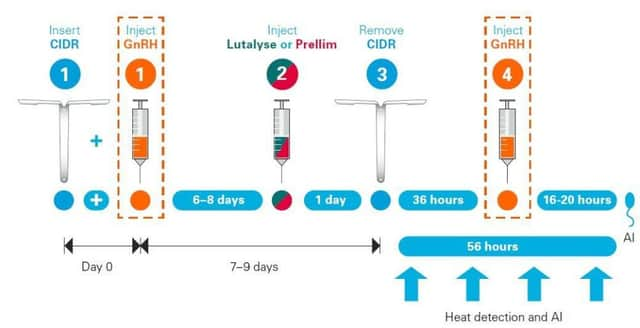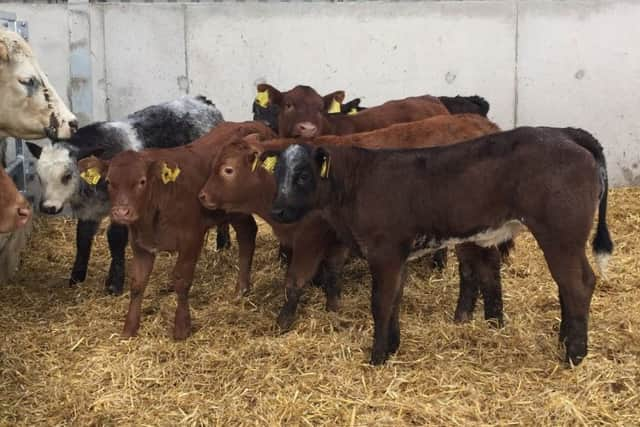Optimising suckler herd performance


Synchronisation and artificial insemination (AI) have many advantages in the suckler herd including:
l Access to quality terminal sires with superior genetics and accurate Estimated Breeding Value (EBV) data allowing selection of specific traits such as easy calving for heifers, terminal characteristics (i.e. growth, carcass) for beef production or maternal characteristics (i.e. milk) for breeding replacements.
Advertisement
Hide AdAdvertisement
Hide Adl Increasing the percentage of cows calved in the first 21 days of the calving period by having groups of cows/ heifers all bred on day 1 of the mating period. Timely and efficient breeding of beef cows and heifers early in the season is crucial to ensure the maximum calf crop during their lifetime and a high and uniform calf crop for sale or rearing each year.


Many beef cows are not cycling at the start of the breeding season, particularly whilst suckling a calf. Breeding protocols that induce oestrus and synchronise ovulation allow breeding of all animals at the start of the season, regardless of their cyclicity status and breeding strategy.
Beef heifers represent both the investment and future prospects of a beef herd. The timely and well planned introduction of heifers is crucial to maximise their life-long production of calves for sale or replacements.
Options for breeding by AI
l AI to Observed Heats


Beef cows that calve in target body condition score (BCS) around 2.5-3 should normally start cycling and show heats within 50-60 days of calving.
Advertisement
Hide AdAdvertisement
Hide AdHeat detection for 20-30 minute periods two-three times daily can be an effective way of selecting cows for AI especially in autumn calving housed cows – early morning and evening are critical times to observe for heats. Heat detection aids such as tail paint and activity meters/pedometers have also been used successfully in beef herds.
Cows or heifers should be inseminated within 12 hours of being seen standing to be mounted.
l Fixed Time AI (FTAI) protocols
Beef cows and heifers can be bred successfully by AI achieving conception rates to match bulls.
CIDR sync can be used in cycling and non-cycling cows and heifers and allows fixed time AI eliminating the need for heat detection. (see graph)
Points to consider for optimum fertility management
Advertisement
Hide AdAdvertisement
Hide Adl Cows should be at least 45 days calved before entering a synchrony programme to ensure best results. Cows calved less than 45 days are more likely to be in anoestrus (non-cyclic) and resulting pregnancy rates from the first post-calving heat may be poor.
l Energy deficiency leading to poor body condition scores (BCS) and prolonged anoestrus is by far the most common cause of poor fertility in many herds. Therefore forward planning is essential to ensure cows are calved at target BCS of 2.5 and 3.0 for spring and autumn calving cows respectively to ensure most are cycling prior to synchronisation. Cows should be divided into overfit, adequate and lean groups at weaning and housing and rationed accordingly.
Cow condition can also be manipulated by varying weaning time- earlier to improve cow condition, later to reduce cow condition. As cows get fatter they have more difficulty calving, increasing the risk of caesareans or even calf mortality. Cows with low body condition scores have higher levels of anoestrus resulting in poorer fertility.
l Maintaining herd health
Parasite control should be planned ahead of time to ensure burdens of stomach worm, lungworm or fluke are not present. Burdens of liver fluke/worms may contribute to poor body condition and lead to poor results with synchrony especially in young autumn calving cows. If liver fluke infection is a risk, then strategic dosing should be carried out prior to breeding/synchrony and not left until the breeding period.
Advertisement
Hide AdAdvertisement
Hide AdControl of infectious diseases is critical to ensure good AI results. The presence of active BVDv, IBR or Leptospira Hardjo in a susceptible group of cows/heifers during a synchrony programme can have disastrous consequences on AI pregnancy rates and therefore infectious disease status of the herd should be established in advance. If herds are vaccinated for BVDv, IBR, leptospirosis etc., vaccine doses must be completed prior to the synchronisation programme starting. Administration of vaccine close to the AI date could reduce conception rates.
l Handling facilities
Some thought should be given to suitability and access of the handling system on farm as cattle will need gathered on several occasions during the programme and for AI. Ideally the crush should be covered, as synchronising a large batch of heifers/ cows in heavy rain/snow is not ideal!
l Managing replacement heifers
Correct management of bulling heifers is paramount to achieving excellent herd fertility.
Sexual maturity in heifers is related to weight rather than age; therefore heifers born earlier in the calving season are likely to be heavier at bulling and are genetically more fertile. In order to achieve first calving at 24 months, management practices should ensure that heifers are of adequate size (65% of mature weight) for successful mating at 15 months. Heifers will need to grow at an average liveweight gain of 0.85-1.0kg/day from birth to hit target weights for mating.
Advertisement
Hide AdAdvertisement
Hide AdMature weight is the weight of cows that have stopped growing. This is usually around 5-6 years of age and will vary across breeds and within breeds depending on genetics. The best way to establish mature weight is to weigh some of your cows, or to check your cow cull weights.
If the mature cows in your herd weigh in the region of 650kg, then heifers should reach target weights of 420kg for first mating.
Tight heifer mating will lead to compact calving as cows. When using natural service, aim to bull for a six week period only or with AI, aim for two turns of AI only. Heifers that fail to conceive within a six week period are likely to be less fertile than their peers and will slip further in future breeding seasons. Heifers should calve easily at start of calving period to ensure they get pregnant as first calvers within the limited mating period.
Using breeding protocols to synchronise heifers can help tighten the heifer calving period as all heifers will be mated on the first day of the mating season and repeats will be served around 21 days later.
Advertisement
Hide AdAdvertisement
Hide AdWhether using AI or natural service, aim to select an easy calving bull with a positive calving ease direct EBV.
Another point to consider when breeding replacement heifers is temperament both for safety reasons and fertility. Research showed that females with excitable temperament had delayed puberty and reduced pregnancy rates.
Financial benefit
l Cost of a bull
A survey of the longevity and reasons for culling in UK beef stock bulls concluded that the average age at culling was 5.8 years and that most bulls are not used until they are at least 18 months old. Therefore most beef bulls only last for about four working years. Over 30% of bulls were culled due to musculoskeletal problems.
Many beef stock bulls sire only around 30-40 calves per year. The true cost including of keeping a reasonable quality stock bull on farm may be up to £1,600 per year. This includes both fixed and variable costs and is based on bull purchase price of £4000 and average longevity of four working years.
Advertisement
Hide AdAdvertisement
Hide AdA reasonable estimate of the cost of each calf produced by natural service is therefore around £45, but could be considerably higher.
Substituting a bull with AI could therefore deliver a cost-benefit.
More kilos of beef at weaning with FTAI
A North American study compared single synchronisation and Timed AI followed by sweeper bulls with a control group (natural service alone) on 1,200 cows in eight herds. Half of the cows were synchronised for single Timed AI on day one of breeding period and bulls were introduced 12hrs after AI completed to all cows.
The cows served by fixed time AI had a better weaned calf crop %, calving pattern, and increased weaning weights leading to $50 advantage per cow bred using FTAI (after deduction of drug/AI costs etc).